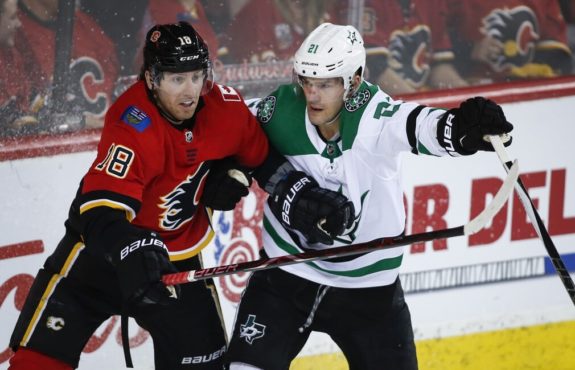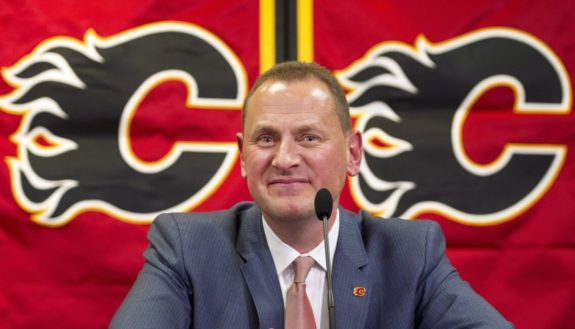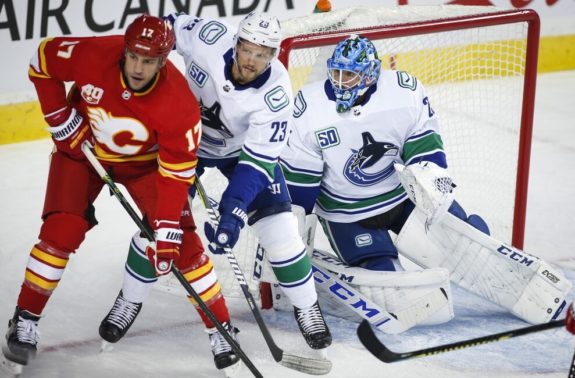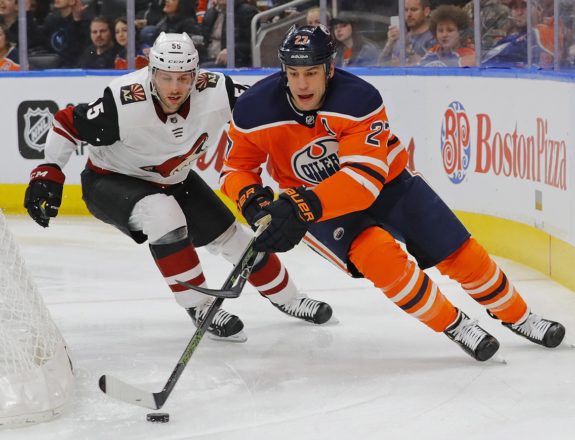Let’s preface this by saying it is way too early to decide who won the James Neal-Milan Lucic trade between the Calgary Flames and the Edmonton Oilers. And, as Eric Duhatschek wisely pointed out when discussing this transaction in The Athletic, not every trade needs to have a winner and a loser. (from ‘Duhatschek Notebook: Neal for Lucic trade is a rare win-win and why the Jets should be patient with Byfuglien,’ The Athletic, 10/11/2019)
But that won’t stop people from making premature comparisons anyway, and after the comparisons come the rationalizations. After Neal’s stunning four-goal performance against the New York Islanders to help the Oilers to start the season 3-0, and then surpassing last season’s goal total in seven games, Flames fans and media personnel began to twist themselves in knots explaining why that wasn’t such a bad look for Calgary.
Many of the rationalizations are absolutely true, others are shaky but get a passing grade. For example:
“James Neal was never going to accomplish that in Calgary.”
Probably not. He was not in great shape in the 2018-19 season, was likely tired after two consecutive Cup Finals, and he didn’t get the opportunity he was hoping for on the top line. Elias Lindholm surprised everyone by fitting so well there. Neal was also rumored to have a salty relationship with Bill Peters. Chalk it up to a bad fit.

“Milan Lucic is bringing much-needed physicality to the Flames.”
That take gets a passing grade. Calgary probably did need more size. Travis Hamonic, Garnet Hathaway and Sam Bennett, seemingly the only three Flames players willing to drop the gloves in defense of a teammate last season, had to fight way above their weight class at times. And don’t forget that Hamonic got injured doing so.
Also keep in mind, however, that the Flames finished atop the Western Conference standings in 2018-19, and entered the playoffs basically injury-free without a designated goon on the roster. So, to say they “needed” more physicality is perhaps exaggerated. Suffice to say they could’ve used it, especially in the playoffs.
There’s one narrative surrounding Lucic, however, that absolutely does not hold water.
Lower Expectations of Lucic Won’t Lead to Disappointment
Stop me if you’ve seen something along these lines, Flames Nation.
“Edmonton needed goals. Calgary needed toughness. The Flames didn’t acquire Lucic expecting him to put up points.”
Nobody knows what general manager Brad Treliving was really thinking when he traded Neal to the Oilers for Lucic and a conditional third-round pick. All we know is what he has told the media. It wasn’t much. He used words like “presence” and “fresh start” multiple times.

But one can deduce that Treliving and the Flames expect more from Lucic than just hits, fights, and the scare factor, by creating simple if-then scenarios.
Example: If the Flames were satisfied with Lucic putting up six goals and a handful of assists, as long as he plays the role of enforcer, as Eric Francis has suggested, then Treliving would have acquired a cheaper option.
Ryan Reaves has a smaller contract.
Erik Gudbranson has a smaller contract.
Even Dalton Prout, who the Flames parted with this summer, could be counted on for six goals and the same amount of penalty minutes as Lucic over a full season.
To quote Adam Wylde:
“If the Flames want a fighter, you can pick up a fighter for 700 grand.”
Via Steve Dangle Podcast. Episode: Real Deal – Oct 9, 2019
No lies detected. If Treliving had acquired Lucic and that monster contract expecting his point totals to remain consistent with the past two seasons, that would have been a massive blunder, with or without a conditional third or salary retained. A judgment call that bad would be uncharacteristic of Treliving.
Sure, the Flames don’t expect Lucic to produce like a top-six forward or play top-six minutes. That’s one of his benefits over Neal; he knows where he fits in the Flames lineup and what his role is. Neal didn’t.

But make no mistake, anyone who is paid $6 million in today’s NHL is expected to put up points. Period. There is likely no way to spin this trade as a “win” for Calgary if Lucic can’t reach at least 0.35 points per game.
That conditional third-round pick, which the Flames will receive from Edmonton if Neal scores 21 goals on the season and Lucic scores at least 10 fewer than Neal, is not at risk. Not by a long shot. Given Neal’s current pace, the Flames will probably still get the pick if Lucic triples his goal tally from last season.
Lucic should also be able to have a more positive impact on the Flames’ puck possession metrics than Neal had. As the numbers attest, that is an extremely low bar.
According to Kent Wilson in The Athletic, James Neal was essentially an anchor for his linemates during his tenure with the Flames. Lucic, who was by no means a superstar last season, out-performed Neal in Corsi, relative shot attempts for, and scoring chances for.
Neal’s [had a] mostly deleterious influence on his linemates, whereas Lucic is mostly green.
Lucic’s aggregate impact on shots and expected goals across his teammates was positive in 2018-19 […] Neal’s impact was strongly negative. In fact, Neal was by far the worst regular skater on the Flames by these sorts of measures.
From ‘A deep dive behind the numbers to gauge expectations for Milan Lucic and James Neal,’ The Athletic NHL, 07/22/2019
The Flames Believe in Lucic
This was a classic “change of scenery” trade. Treliving expects a resurgence from Lucic, not only in terms of motivation, but also point totals. All logic points to that fact.

Some argue that it’s important to separate the player from the contract, to discuss one without discussing the other. That statement has a lot of merit. But for a general manager in the cap era, the contract is the first thing you should consider.
Having considered the cap hit and the no-move clause, Treliving has shown he believes in Lucic. The trade itself was a vote of confidence that Lucic can rebound.
Another concerning quote from Eric Francis:
[Neal] leads the NHL in goals (6); [Lucic] in penalty minutes (26) and fights (2).
Yes, it’s early.
But so far both have fit in exactly the way their new teams had hoped, leaving fans in their previous stops scratching their heads.
No self-respecting Edmonton fan is scratching their head right now. Oiler fans are not sitting at home, watching Neal break franchise records for early-season goals, wishing they could somehow get more penalty minutes, or that their team was tougher.

For context, these quotes from Francis came during and after the Flames’ Oct. 8 matchup against the Los Angeles Kings, in which the Flames were being badly outplayed through the first 30 minutes. Lucic fought Kurtis MacDermid in the second period in retaliation for an open-ice hit. According to Flames players and fans alike, that moment sparked the Flames to come back from a three-goal deficit and force overtime.
If a passionate fight or a timely hit sparks your team to victory, that’s awesome. If toughness and grit prevent your skill players from getting injured, all the better.
The fact remains that any team can acquire those elements for far less money than Lucic makes. Which means that Treliving had his reasons for pursuing this player in particular, and those reasons go beyond just being an enforcer.
Lucic is expected to put up points. Actual hockey points. He has already started doing so with a solid performance against the Detroit Red Wings, and still has an entire season to build on that. But if he repeats his point totals from last season, the Flames still come out of this trade with egg on their face.